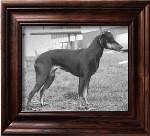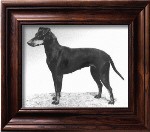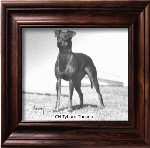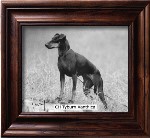Kennels featured
Janmark
Talanors
Digelsa
Rosettia
Plantocracy
Ruffagga







Stud dog Information
Your role as the owner
As the owner there are some key roles you should play in making sure the mating goes smoothly, including:
- providing a stud contract
- supervising the actual mating
- knowing how to handle the bitch to ensure mating
- ensuring the dogs are safe after they tie and that neither dog is hurt or injured
- assisting or advising if the bitch shows little interest in mating
- being available to give advice to the owner of the bitch on whelping or puppy care
- being willing to help with any problems with the puppies, i.e. health issues, rehoming etc.
Using your dog on a bitch that is not well matched may have an impact on the puppies produced and your dog’s reputation. It is your responsibility to ensure that a mating between the two dogs is justified and that a mating will be beneficial to the breed.
An interview with Nerolie de Lavis-Trafford .....
Choosing a stud dog is difficult
|
Choosing a stud dog is difficult, whether you are knowledgeable about the breed or a beginner planning your first litter. To start with, one of the most helpful bits of advice I have ever been given was from the breeder of our first Manchester. Although she could have suggested we use any one of her Stud Dogs, she advised us, instead, to take a good objective look at our bitch; decide in our own minds what were her weaker points and then look out for a dog we felt might offset those weaknesses.
However, listed below are some Do's and Don'ts which could help you in making a decision. Here are some basic essential rules that I as an experienced breeder would recommend to you
The following are a few of my experiences over the years - and the thinking that went into the choice of the stud dog; in the hope that there might be something helpful to the reader. One DOES make mistakes, hopefully one learns! |
|
Although at the time it seemed a nice idea to have a litter, how to start? How does one decide what dog to use? Where do we start our search ? What were we looking for?
Perhaps because we were country people at heart and had always enjoyed the company of animals, or perhaps everyone is like that, we had always liked things to look as good a specimen of whatever animal or breed they represented.
|
The Stud Dog for Skippy
Although we had talked to the secretary of the club and the breeder, we still felt very unsure of ourselves. We had seen a dog with an outstandingly good front and a general outline that went with it. Surely it could only do good. And, so it turned out - from Ch. Eaglespur Lord Pegasus we got Tyburn Anthony, a great sire of champions, and our Rea, who had that wonderful graceful stride, so rarely attained in our breed. It covers any kind of terrain effortlessly, and could go on for miles - and she had the shoulder and pasterns to go with.
|
The stud dog for Rea
Rea was my dog and tended to keep herself to herself. The dog I chose was Eaglespur Majesty, a dog that was occasionally shown in the dog show ring. He seemed delighted to be there and see everybody. To many he may have appeared smallish and a bit plain, he was certainly not fashionable as a sire at that stage. The mating resulted in Gale (CH Tyburn Galisiaca), Gale was a real charmer, a little bit small but very beautiful and loved everyone. A repeat mating produced Nimble (CH Tyburn Iris Nimble Feet), a younger sister for Gale, she was also friendly and had this great fearless swagger about her, that brought so many honours in the show ring. |
The Stud Dog for Gale
Clearly
with Gale (CH Tyburn Galisiaca) being so "petite" I needed to look
for more bone and size. I found a stunning handsome
dog. He was unshown, I believe, but seemed friendly and
outgoing, although slightly on the large side. His name
was Eaglespur Royal
Crest.
The mating resulted in Rookie (CH Tyburn Karukion), Rookie inherited his mother's lovely temperament and his fathers handsome head. He had enormous depth and much elegance, but, not very strong hindquarters and was a bit fine boned for his size; these were some of the reasons I never felt justified in using him at stud myself, sadly.
The Stud Dog for Nimble
Nimble
was quite the swagger, she was very much the terrier. The dog
we chose was Ch Eaglespur Thorn, he was a fairly heavy dog,
but he had a strong head and a decent
temperament.
The result of this mating was Cely (CH Tyburn Nereis of Hardway), she was very similar in type to her mother Nimble and again was very much a terrier.
The Stud Dog for Cely
I
still did not feel sure about using Rookie at stud, so I thought
one of his sons would be an indirect way of using Tyburn
bloodlines. Ch Hardway Hegeman was a nice dog with a kind
temperament although he had inherited a certain lack of strength at
the back.
The result of this mating was Thea (Ch Tyburn Theano), Thea could not have been a gentler more charming , devoted little dog. She was fine boned, very good looking and had an exceptional intelligence.
The stud dog for Thea
Clearly
the depth of bone was of first importance. We searched out a
fairly stocky dog in the name of Eaglespur
Sunset
The result of this mating was Zara (Ch Tyburn Xanthica). She is a good size, has elegance and is a delightful mover.
The stud dog for Zara
In addition to her qualities stated above, I was aware of a few minor points to consider for any possible mating. I was conscious of her rather stuffy neck and the need to strengthen the under jaw. I can honestly say that I took a risk on a slightly stronger built dog that I felt would improve these qualities, I chose Eaglespur Crownland, a handsome dog.
The result of this mating gave me Nikie (Ch Tyburn Berenice), she is a really lovely bitch with a great reach of neck, handsome head and enough bone.
The stud dog for Nikie
|
Nikie was bold as a youngster but there was an unfortunate accident whilst I was abroad, this has made her shy until she gets to know you. Basically she is a lovely, affectionate dog. She did well in the show ring as a puppy and at 2 1/2 years she was top winning bitch in the breed. I personally feel she is a little oversized, I was aware of this when choosing a stud dog for her but not too bothered because I was pleased with all of her other qualities. I chose Eaglespur Faithful Edward, sadly he died some months later - he had shown great promise and was a sad loss. The mating gave me Fudge (Ch. Tyburn Faedra). Fudge is smaller than Nikie and has a better shoulder inherited from her father. She has kept all her mothers good points.
|
|
My final summary on choosing a stud dog.
Choosing a stud dog is a problem for anyone, and one needs some kind of rule of thumb. I think the breed standard gives one a "Norm", and for us I suppose we just wanted to produce as good a specimen as possible, incorporating soundness and temperament. It has been said that all breeders can think of is winning in the show ring. WRONG. We have NEVER EVER had that an an aim - in fact I can honestly say, it never crossed my mind when breeding. Although, obviously, it would always be wonderful if something one had bred was successful. BUT always bear in mind that apparent good looks does not guarantee soundness, good temperament and good health. The breed is blessed with good health and no inherited diseases. Let us not spoil that record by indiscriminate, careless or selfish breeding. From an unreliable temperament 35 years ago to the friendly dogs we have now is a great advance. The standard states "discerning". let no one mistake that for bad temperament. I am happy that though friendly, my dogs will not go off with any strangers. I hope you find something of help in the above.
|